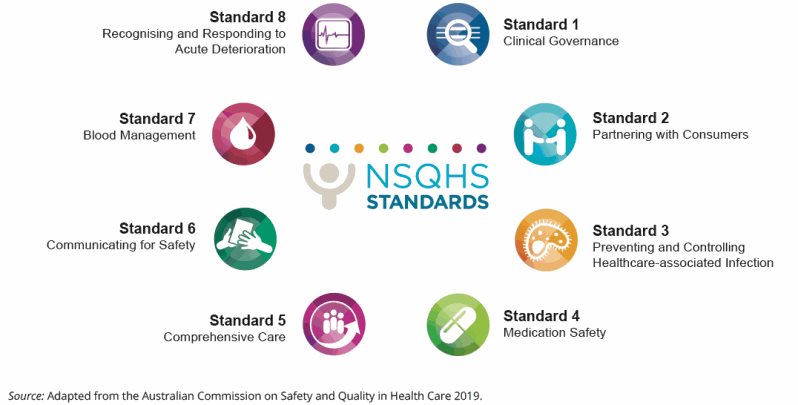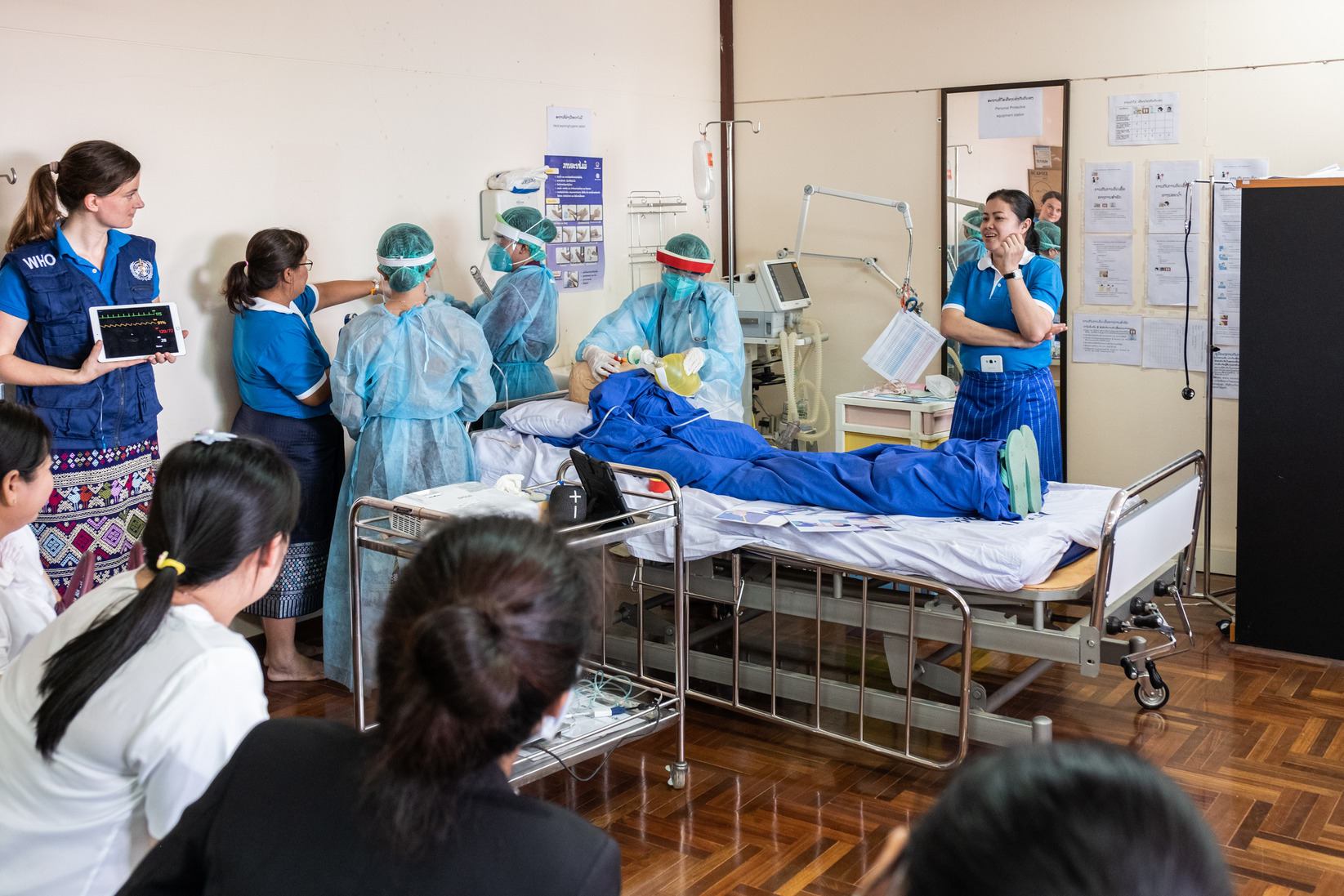.tmb-768v.png?Culture=en&sfvrsn=54737d84_1)
The impact of accreditation on the quality of Australian health services
Disclaimer
Background and overview of the accreditation programme
Accreditation of healthcare organizations has become an important means of promoting safety and quality improvement internationally. The Australian accreditation programme was driven by a series of landmark safety and quality studies and reviews which found that patients were not always receiving evidence-based hospital care. Australia’s accreditation programme was initially implemented in the hospital setting, with accreditation being undertaken by the Australian Council on Healthcare Standards (ACHS) since 1974.
Australia established a new government agency to develop accreditation standards, the Australian Commission on Safety and Quality in Health Care (ACSQHC) who developed the National Safety and Quality Health Service (NSQHS) standards.
The first edition of the NSQHS standards, released in September 2012, was developed by the ACSQHC in consultation and collaboration with jurisdictions, technical experts and a wide range of stakeholders, including health professionals and patients. Based on feedback, the standards were revised and the second edition was released in 2017.
The primary objectives of the NSQHS Standards are:
- to protect the public from harm,
- to improve the quality of health service provision.
The 10 NSQHS Standards include:
- Governance for Safety and Quality
- Partnering with consumers
- Prevention and control of healthcare-associated infections
- Medication safety
- Patient Identification and procedure matching
- Clinical handover
- Blood management
- Prevention and management of pressure injuries
- Recognising and responding to acute deterioration
- Prevention of falls and harm from falls
The NSQHS Standards form the central platform of the Australian national accreditation scheme and are used to assess health service organization performance. Organizations become accredited against the NSQHS Standards through the Australian Health Service Safety and Quality Accreditation Scheme (AHSSQA Scheme).
Accreditation policy is set by the federal government agency, the Australian Commission on Safety and Quality in Health Care (ACSQHC). The state and territory health departments determine which health service organizations must be assessed against the NSQHS Standards.
Generally, there are different standards for different types of health services, although one health service may require assessment across a range of relevant standards.
The accreditation scheme is mandatory for all public and private hospitals, day procedure centres and public dental practices.
There is a three-year accreditation cycle in which assessors from approved accreditation agencies rate actions as “met”, “met with recommendations” or “not met”. Assessments are usually announced and planned in advance. Following a pilot of a short notice model conducted by the ACHS, as of 2019, health care organizations can choose to undertake either announced or short notice assessments. Short notice assessments have become mandatory across Australia since July 2023.
In terms of funding, prior to 2013, ACHS funded the development of the standards used for accreditation across Australia. Since 2013, with the introduction of the NSQHS Standards, the Federal Government has funded the development of national standards. ACHS continues to support the funding of the ACHS EQuIP standards.
ACHS is a not-for-profit, independent accreditation agency. It is the largest of the 6 accreditation agencies operating in Australia.
Health services are charged a fee for the accreditation assessment. An Australian paper that pre-dates the current accreditation scheme (pre-2013) indicated that accreditation costs ranged from 0.03% to 0.60% of total hospital operating costs per year, averaged over the 4-year accreditation cycle. (Mumford V, et al. Counting the costs of accreditation in acute care: an activity-based costing approach. BMJ Open 2015;5: e008850)
How was accreditation used to improve the quality of health services?
Facilities are provided with a range of information resources from the Australian Government, support from State Governments for the public sector, support from professional organizations for the private sector and support from accrediting agencies to prepare for accreditation processes and quality improvement strategies.
The external surveys themselves involve pre-announced visits, followed by provision of feedback and re-evaluation, providing an opportunity to demonstrate a cycle of improvement.
The collection and analysis of feedback on the lessons learned from accreditation is used by national agencies and health services for quality improvement. The ACSQHC uses feedback to identify areas where health services may require additional support or tools.
What were the results of this activity?
Ninety-nine percent of eligible facilities participate in accreditation. This includes the accreditation of 1311 hospitals and day procedure services. (NSQHS Standards assessment outcomes | Australian Commission on Safety and Quality in Health Care).
Improved compliance with the NSQHS Standards has been reported following participation in accreditation. The standards have improved patient safety and the quality of health care in Australia across a range of outcome measures such as central line-associated bloodstream infections.

Sentinel events, which have a significant impact on patients, have decreased nationally since the implementation of the NSQHS Standards and the introduction of external accreditation.
A 2018 ACSQHC report showed that, in addition to enhanced compliance, patient safety and the quality of health care had improved. Improvements included:
- Reduced rates of healthcare-associated infections.
- Reduced in-hospital cardiac arrests.
- A reduction in the number of annual red blood cell issues by the National Blood Authority.
- Better documentation of adverse drug reactions and medication histories; and
- Reduced antibiotic prescribing due to improvements in antibiotic stewardship.
(Australian Commission on Safety and Quality in Health Care. Creating Safer, Better Health Care – The Impact of the National Safety and Quality Health Service Standards. Sydney: ACSQHC, 2018)
In addition, there was a decline of almost fifty percent in the national rate of central line-associated bloodstream infections between 2012-13 and 2013-14, from 1.02 to 0.6 per 1000 central line days.
Another interesting outcome is that eighty-four percent of Australian hospital boards reported that, as a result of the programme, they understood and enacted their roles and responsibilities in relation to patient safety and quality.
 WHO / Blink Media - Bart Verweij, source: WHO Photo Library
WHO / Blink Media - Bart Verweij, source: WHO Photo Library
What were the key challenges involved? How were these challenges overcome?
State and territory regulators and chief executives of health service organizations raised concerns about some aspects of the AHSSQA Scheme (e.g., availability of supporting tools and consistency of assessments).
In 2017/18, ACSQHC undertook a comprehensive review of the assessment processes in response to the feedback received. Following this review, ACSQHC developed six strategies to improve the reliability of the accreditation scheme to more accurately assess an organization’s compliance with the NSQHS Standards.
These strategies are to:
- Improve the veracity of assessments of health service organizations.
- Improve the effectiveness and expertise of the assessment team.
- Assess the health service organization’s safety and quality data to better inform the assessment processes.
- Improve regulatory oversight.
- Improve communication about the assessments and their outcomes.
Improve resources and support for health service organizations. Further details can be found in the Review of the Australian Health Service Safety and Quality Accreditation Scheme: Improving the reliability of health service organization accreditation processes.
One important health system challenge for the accreditation scheme is the ongoing evolution of care delivery models and care integration across traditional sectors with historically separate sources of funding.
Key learning points
An important overall enabler in the Australian accreditation scheme is that accreditation is mandatory for public and private hospitals, day procedure centres and public dental practices.
The development and revision of the safety and quality standards is facilitated by the resourcing of a national agency.
Key learning points:
- A well-resourced national agency with continuous commitment to programme implementation is crucial to success.
- Clearly stated expectations help to prepare for and respond to accreditation.
- Supporting increased awareness and knowledge of quality and safety in the delivery of health services.
- Support provided by the accreditation agencies appears to be more successful when it focuses on facilitating knowledge sharing and peer discussion.
- Clear interpretation of the impact of standards on quality and quality improvement is key to uptake.


